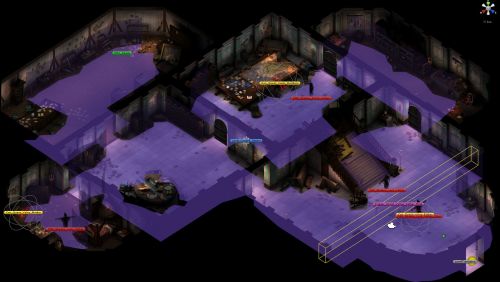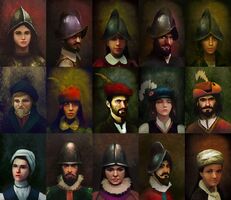Project Eternity Kickstarter Update #67: How To Create An Area, In 13 Days Or More
Project Eternity Kickstarter Update #67: How To Create An Area, In 13 Days Or More
Development Info - posted by Infinitron on Wed 13 November 2013, 01:42:07
Tags: Brandon Adler; Obsidian Entertainment; Pillars of EternityIn this week's Project Eternity Kickstarter update, Obsidian producer Brandon Adler explains the processes of how a small area in the game is created, from beginning to end, and in great detail. It's very long, so I'll just quote the summarizing bits:

The Schedule
One thing to remember is that when we are in the middle of production the schedule has already been created for just about everything in the game. What I mean by this is that we have identified all of the major tasks that will need to be accomplished and allotted time and resources in our budgets to match those tasks.
Depending on the team's familiarity with the type of game we are creating, this can mean anywhere from a tiny bit of guesswork to larger amounts of... estimation. With Eternity we are very familiar with what it takes to make an isometric, Western RPG with branching dialogues and reactivity. It's Obsidian's bread and butter. Because of this our initial estimates are good approximations.
Since most of our features and assets are budgeted at the start of the project, any changes to those items have to be accounted for in the schedule. This can mean a few different things - anything from reducing time spent on other tasks, to changing previously scheduled items, to outright cuts - and when changes need to happen project leads consult with each other to try and figure out the best option. Keep this in mind when I start talking about changes to features and assets later on in this update.
One Small Interior Dungeon
Alright, let's stop talking in generalities and get into the meat of what it takes to create a first pass area in Eternity. I'll discuss a generic small interior dungeon area.
This area will have the following characteristics and constraints:
Our time estimations used for scheduling are determined in preproduction (prepro) phase. Our vertical slice (the end of prepro) is the culmination of the team identifying what it will take to make the game and then actually doing it. We get these numbers by seeing how long it takes the team to perform those tasks in our prepro, and then we can extrapolate those numbers over the course of the time we have budgeted to understand how much work can get done.
Tough Choices
A milestone will have 15 to 20 areas of varying complexity going at a time. A minor change in an area can cause a domino effect that starts schedule slippage. Remember that on a small team like Project Eternity we have a limited number of people that can work on any one part of the game so taking someone off of their current task to work on changes can gum up our pipelines and prevent others from completing their tasks. We can get around that by switching up the tasking, but it can quickly get out of hand and lead to inefficiencies.
That being said it's the team's responsibility to give our backers what they have paid for. If we are playing though part of the game and something feels off from what we promised to our fans, we need to seriously consider making changes - even if it pushes us off schedule. There have been times where an update leads to some serious discussion on the forums and within the team about a direction change. Ultimately all of that gets added into the equation as well.
Taking that into consideration, the team has to make difficult choices every day. Do we go through and do another prop pass on a level? What does that cost us in the long run? Will we lose an entire area in the game? These are questions that the leads struggle with everyday. We are always weighing the cost of assets and features against everything that still needs to get done.
I believe this particular update should be of interest to a certain poster by the name of Mrowak. One thing to remember is that when we are in the middle of production the schedule has already been created for just about everything in the game. What I mean by this is that we have identified all of the major tasks that will need to be accomplished and allotted time and resources in our budgets to match those tasks.
Depending on the team's familiarity with the type of game we are creating, this can mean anywhere from a tiny bit of guesswork to larger amounts of... estimation. With Eternity we are very familiar with what it takes to make an isometric, Western RPG with branching dialogues and reactivity. It's Obsidian's bread and butter. Because of this our initial estimates are good approximations.
Since most of our features and assets are budgeted at the start of the project, any changes to those items have to be accounted for in the schedule. This can mean a few different things - anything from reducing time spent on other tasks, to changing previously scheduled items, to outright cuts - and when changes need to happen project leads consult with each other to try and figure out the best option. Keep this in mind when I start talking about changes to features and assets later on in this update.
One Small Interior Dungeon
Alright, let's stop talking in generalities and get into the meat of what it takes to create a first pass area in Eternity. I'll discuss a generic small interior dungeon area.
This area will have the following characteristics and constraints:
- Uses an existing "tileset." We don't have tiles in Eternity, but we do have sets of areas that share similar assets.
- Will have one unique visual feature in the area. This visual feature is something that will make the area stand out a bit. It doesn't have to be incorporated into the design, but we may want to do that to get the most bang for the buck.
- An Average complexity quest uses this area. "Average" is a flavor of quest in Project Eternity. It refers to the overall complexity of the quest. Quest complexity is determined by the amount of dialogue, branching, and steps a quest has.
- This is a 3x3 interior. A 3x3 interior is the equivalent of a 5760x3240 render. An easier way to think about it is that a 3x3 area is nine 1920x1080 screens worth of content. You can imagine that making an area even a tiny bit larger can actually lead to enormous amounts of work. As an example, a 3x3 is nine screens of work, where a 4x4 is 16 screens of work... almost double the number of screens.
Our time estimations used for scheduling are determined in preproduction (prepro) phase. Our vertical slice (the end of prepro) is the culmination of the team identifying what it will take to make the game and then actually doing it. We get these numbers by seeing how long it takes the team to perform those tasks in our prepro, and then we can extrapolate those numbers over the course of the time we have budgeted to understand how much work can get done.
Tough Choices
A milestone will have 15 to 20 areas of varying complexity going at a time. A minor change in an area can cause a domino effect that starts schedule slippage. Remember that on a small team like Project Eternity we have a limited number of people that can work on any one part of the game so taking someone off of their current task to work on changes can gum up our pipelines and prevent others from completing their tasks. We can get around that by switching up the tasking, but it can quickly get out of hand and lead to inefficiencies.
That being said it's the team's responsibility to give our backers what they have paid for. If we are playing though part of the game and something feels off from what we promised to our fans, we need to seriously consider making changes - even if it pushes us off schedule. There have been times where an update leads to some serious discussion on the forums and within the team about a direction change. Ultimately all of that gets added into the equation as well.
Taking that into consideration, the team has to make difficult choices every day. Do we go through and do another prop pass on a level? What does that cost us in the long run? Will we lose an entire area in the game? These are questions that the leads struggle with everyday. We are always weighing the cost of assets and features against everything that still needs to get done.
















